AMD Kaveri Review: A8-7600 and A10-7850K Tested
by Ian Cutress & Rahul Garg on January 14, 2014 8:00 AM ESTCPU Performance: Continued
Xilisoft Video Converter 7 - link
The XVC test I normally do is updated to the full version of the software, and this time a different test as well. Here we take two different videos: a double UHD (3840x4320) clip of 10 minutes and a 640x266 DVD rip of a 2h20 film and convert both to iPod suitable formats. The reasoning here is simple – when frames are small enough to fit into memory, the algorithm has more chance to apply work between threads and process the video quicker. Results shown are in seconds and time taken to encode. XVC also offers acceleration via CUDA and AMD APP, so if these are available on the CPU we offer results with and without.
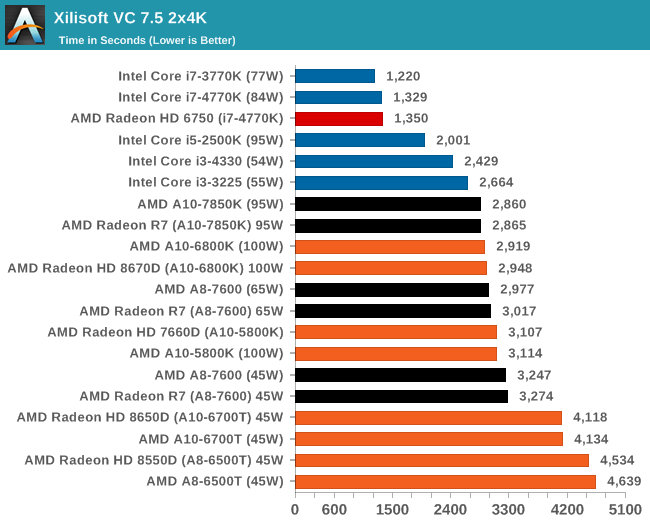
With large frame data, the IGP on Kaveri does not particularly help much.

For smaller frames however, there is an advantage to enabling the AMD APP function.
HandBrake v0.9.9 - link
For HandBrake we do the same files as XVC but convert them into the default format Handbrake offers upon loading the software. Results shown are in Frames Per Second.

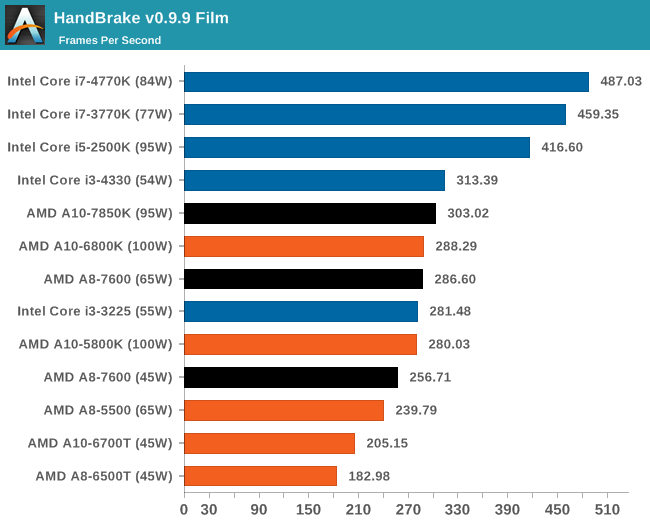
Handbrake loves cores, threads and MHz
Adobe After Effects 6
Published by Adobe, After Effects is a digital motion graphics, visual effects and compositing software package used in the post-production process of filmmaking and television production. For our benchmark we downloaded a common scene in use on the AE forums for benchmarks and placed it under our own circumstances for a repeatable benchmark. We generate 152 frames of the scene and present the time to do so based purely on CPU calculations.

7-Zip 9.2 - link
As an open source compression tool, 7-Zip is a popular tool for making sets of files easier to handle and transfer. The software offers up its own benchmark, to which we report the result.
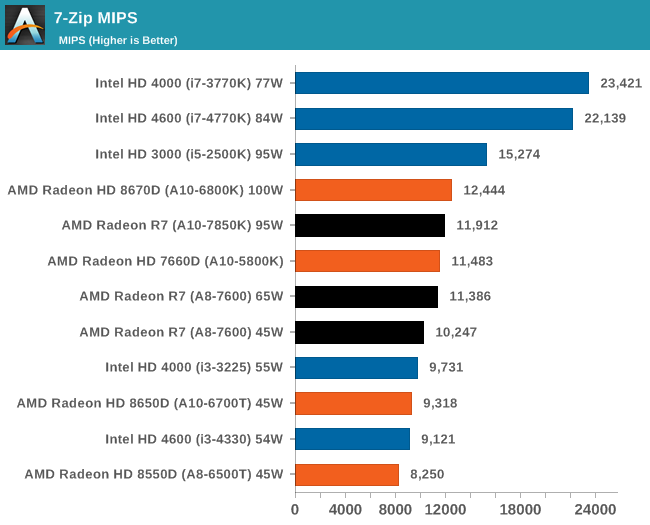
PovRay 3.7 - link
PovRay historically loves threads, MHz and IPC. The standard benchmark from PovRay is what we use to test here.
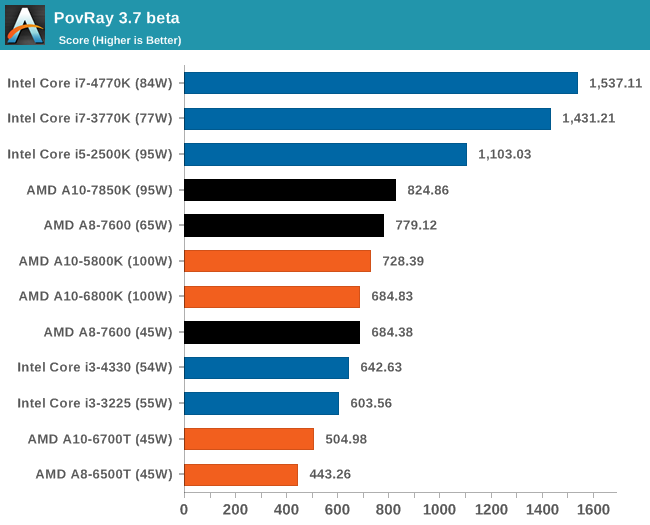
TrueCrypt 7.1a - link
TrueCrypt is an off the shelf open source encoding tool for files and folders. For our test we run the benchmark mode using a 1GB buffer and take the mean result from AES encryption.
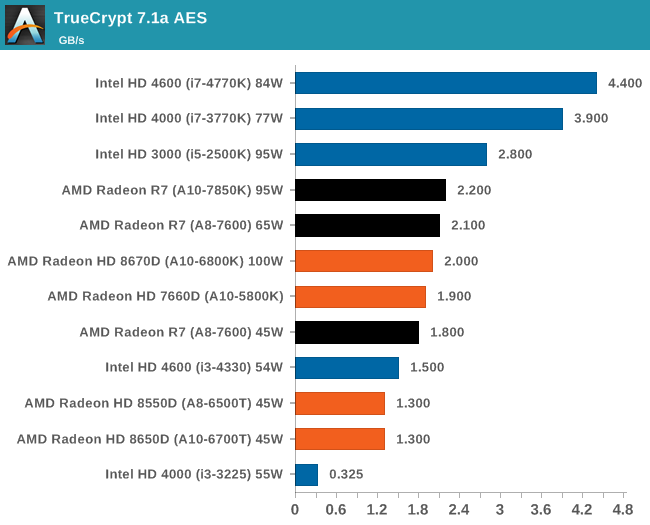










380 Comments
View All Comments
Fox5 - Tuesday, January 14, 2014 - link
Where are the Iris Pro results in CLBenchmark? Where are the CPU results of CLBenchmark; is the GPU faster than Haswell's AVX2? Where's the rest of the compute benchmarks, the area that Kaveri is supposed to shine in?JDG1980 - Tuesday, January 14, 2014 - link
Incidentally, will HTPC be covered in a different review? MadVR could be a good use case for Kaveri, as it requires quite a bit of shader power but isn't that memory bandwidth intensive.beomagi - Tuesday, January 14, 2014 - link
Per charts, Why are 100W APUs slower in 1280x1024 than at higher resolutions??beomagi - Tuesday, January 14, 2014 - link
Also, 45W APUs are faster? Are the benchmarks different? The charts only mention resolution.beomagi - Tuesday, January 14, 2014 - link
Nevermind - I now see this is as a percent difference compared to the slower chip - the title said FPS and that threw me off.Ignore! :D
Dribble - Tuesday, January 14, 2014 - link
Call me cynical but it's just the same as the previous gen. If you want a small form factor extreme budget gaming box these will be pretty good. For the rest of the world if you don't care about games you'd do better going Intel, and if you do intel + a proper graphics card.As with previous gen it comes with a load of marketing slide advantages, which if previous gen are anything to go by will come to nothing - I don't see the current range of AMD machines blowing away intel machines with opencl/stream/fusion/whatever - and that was what was on the previous set of marketing slides.
I always thought their best bet was mobile - but these days that markets getting really tough now for AMD as Intel have just spent the last few years optimising power usage.
UtilityMax - Tuesday, January 14, 2014 - link
The biggest elephant in the room is that very few average people (those who don't visit this web site) care for playing games on laptops (or even desktops, considering the consoles). Once you ignore the gaming performance, the A10 APU effectively has the performance of Core i3, but at a high price. A Fry's or Best Buy "special" laptop with Core i3 can cost as low as $400 or less. But the A10 laptops cost around $500. Intel's pricing is pretty aggressive on the low end IMHO.jimjamjamie - Thursday, January 16, 2014 - link
Not just in laptops, the price/performance ratio of the dual-core Pentiums is extremely good - the Haswell-based Pentium G3220 (3GHz dual core, 3.5MB cache) is available in the UK for just over £40, which is excellent value.Nagorak - Wednesday, January 15, 2014 - link
Yes, the issue is that the hybridization of CPU/GPU really provides no advantages. For someone actually playing games the GPU is still too weak and they'd be better off with a discrete card. For someone not playing games the quality of the integrated GPU doesn't matter.Maybe I'm wrong and there are tons of people out there playing games at ~30 FPS with low settings. I just don't see why someone who wants to play games wouldn't try to cough up an extra $100 for a discrete GPU, and if you don't play games then even Intel's older HD GPUs are fine.
mikato - Wednesday, January 15, 2014 - link
*For someone actually playing [newer 3D intensive] games the GPU is still too weak and they'd be better off with a discrete card. Yep*For someone actually playing [older or lighter] games the GPU is good enough and you end up with a cheaper overall package without needing a discrete card.
*For someone not playing games, they will benefit big time from HSA eventually. Not there yet and depends on the software.
There are probably more people in the last two categories if you think about it. AMD isn't for us gamers right now unfortunately. And it's going to take a while for adoption for HSA to bring in the third category of people.